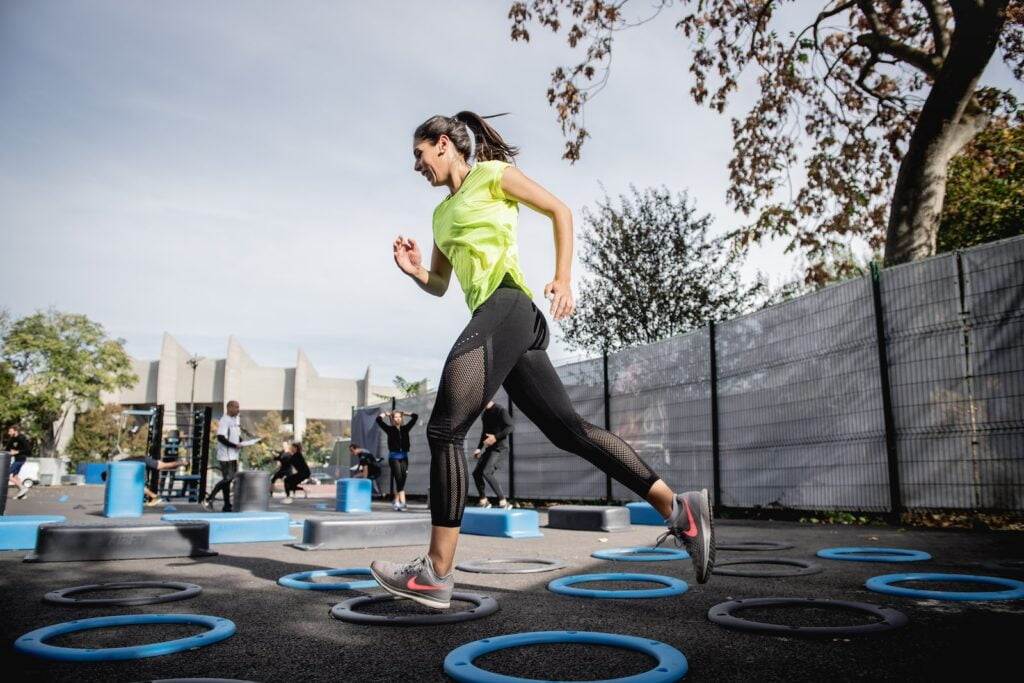Outdoor exercises are great stress relievers. Outdoor exercise reduces stress and improves well-being. Walking, running, cycling, yoga, hiking, and swimming can boost your mood. This article will explain why outdoor exercises reduce stress, list the best ones, and provide tips for successful outdoor workouts. You’ll be happier, healthier, and less stressed if you follow these outdoor exercises tips.
Table of Contents
Benefits of Outdoor Exercises
Improving Mental Health
Outdoor exercises have many mental health benefits. According to a study, exercising in nature can improve mood and self-esteem and reduce tension, anger, and depression1Barton, J., & Pretty, J. (2010). What is the best dose of nature and green exercise for improving mental health? A multi-study analysis. Environmental Science & Technology, 44(10), 3947-3955. https://pubs.acs.org/doi/10.1021/es903183r. Outdoor exercises release endorphins, the body’s “feel-good” chemicals that reduce stress and boost well-being. Being in nature increases mindfulness and focus, both of which can improve mental health.
Boosting Physical Fitness
Outdoor exercises have many benefits for overall fitness. Outdoor workouts improve cardiovascular endurance, muscular strength, flexibility, and balance by providing a varied and dynamic environment. Running on uneven terrain engages more muscle groups than running on flat ground. Wind and varied terrain can increase exercise intensity, burning more calories and improving fitness. In addition to these advantages, outdoor exercises expose the body to sunlight, which helps the body produce vitamin D, a crucial nutrient for bone health and immune system function.
Getting Started with Outdoor Exercises
Finding the Right Exercise
When beginning an outdoor exercise routine, it’s essential to find activities that suit your individual preferences and needs. The ideal exercise should be enjoyable and engaging, as this increases the likelihood of long-term adherence to a fitness regimen2Teixeira, P. J., Carraça, E. V., Markland, D., Silva, M. N., & Ryan, R. M. (2012). Exercise, physical activity, and self-determination theory: A systematic review. International Journal of Behavioral Nutrition and Physical Activity, 9(1), 78. https://ijbnpa.biomedcentral.com/articles/10.1186/1479-5868-9-78. To determine the best outdoor exercise for you, consider factors such as:
- Your current fitness level
- Your personal interests
- The availability of outdoor spaces and facilities in your area
- The types of activities that fit your schedule and lifestyle
Trying out various outdoor exercises can help you discover which activities resonate with you the most. As you experiment, keep in mind that the key is to find an exercise that is enjoyable and sustainable, ensuring that you stay motivated and committed to your fitness journey.
Setting Realistic Goals
Setting realistic goals is an essential aspect of starting any fitness routine. Establishing achievable objectives can help keep you motivated and prevent feelings of frustration or burnout. To set realistic goals, consider the following guidelines:
- Start small: If you’re new to outdoor exercise, begin with moderate-intensity activities that are suitable for your fitness level. Gradually increase the duration and intensity of your workouts as you become more comfortable and confident.
- Be specific: Instead of setting vague goals, such as “exercise more,” outline concrete objectives, like “walk for 30 minutes, three times per week.”
- Make it measurable: Develop a method for tracking your progress, whether it’s through a fitness app, a journal, or a simple calendar. Seeing your progress over time can help you stay motivated and committed to your goals.
- Set time-bound goals: Establish a timeframe for achieving your objectives, but be flexible and adjust your goals as needed. Life happens, and it’s important to be adaptable when circumstances change.
By setting realistic goals and gradually increasing the intensity of your outdoor exercises, you can create a sustainable fitness routine that leads to long-term physical and mental health benefits.

9 Great Outdoor Exercises
When embarking on your outdoor fitness journey, it’s helpful to familiarize yourself with the various types of exercises available. Below, we explore some popular options and discuss their benefits and tips for getting started.
Walking
Walking is an accessible and low-impact exercise that can be enjoyed by individuals of all fitness levels. Regular walking has been shown to improve cardiovascular health, enhance mood, and promote weight loss. To get started, choose a comfortable pair of walking shoes and select a scenic route in your neighborhood or a nearby park. Begin with a brisk 15- to 30-minute walk, gradually increasing the duration as you build endurance.
Running
Running is a more intense aerobic activity that provides a multitude of physical and mental health benefits, including improved cardiovascular fitness, stress reduction, and increased bone density. To begin a running routine, start with a walk-run method, alternating between walking and jogging intervals to gradually build stamina. Be sure to wear appropriate footwear and listen to your body to avoid injury.
Hiking
Hiking is a versatile outdoor activity that can be tailored to various fitness levels and preferences. Hiking in nature has been associated with improvements in mental well-being, increased cardiovascular fitness, and enhanced muscular strength[^10^]. When starting a hiking routine, select a trail that matches your fitness level, wear appropriate footwear, and pack essentials such as water, snacks, and a map.
By exploring different types of outdoor exercises and finding activities that resonate with you, you can create an engaging and sustainable fitness regimen that meets your unique needs and preferences.
Cycling
Cycling is a low-impact exercise that can improve cardiovascular fitness, build muscle strength, and enhance joint mobility. To start cycling, choose a bike that fits your body size and select a route with minimal traffic. Begin with a short, leisurely ride, and increase the distance and intensity as you become more comfortable.
Yoga
Yoga is a versatile mind-body practice that combines physical postures, breath control, and meditation to promote flexibility, strength, and mental clarity3Ross, A., & Thomas, S. (2010). The health benefits of yoga and exercise: a review of comparison studies. The Journal of Alternative and Complementary Medicine, 16(1), 3-12. https://www.liebertpub.com/doi/10.1089/acm.2009.0044. Practicing yoga outdoors can enhance the experience by connecting you with nature and providing a tranquil setting for relaxation. To begin an outdoor yoga practice, choose a flat, comfortable surface, such as a grassy area or a yoga mat, and start with basic poses like downward-facing dog, warrior, and tree pose. You can also explore local outdoor yoga classes or follow guided sessions online to help you get started.
Swimming
Swimming is a low-impact, full-body workout that offers numerous health benefits, such as improved cardiovascular fitness, muscle toning, and joint mobility. Outdoor swimming in natural bodies of water, such as oceans, lakes, or rivers, can provide a refreshing change of scenery and an opportunity to connect with nature. To begin an outdoor swimming routine, choose a safe and supervised location, wear appropriate swimwear, and start with short swimming sessions, gradually increasing the duration and intensity as your fitness level improves. Remember to always swim with a buddy or under the watch of a lifeguard for safety.
Bodyweight Exercises
Bodyweight exercises are an effective and convenient way to build strength and endurance without the need for gym equipment. These exercises utilize your body’s weight as resistance, making them an ideal option for outdoor workouts. Examples of bodyweight exercises include push-ups, squats, lunges, and planks. To begin a bodyweight exercise routine, choose a series of exercises that target different muscle groups and perform them in a circuit, with short rest periods in between. Gradually increase the number of repetitions and sets as your strength improves.
Outdoor Group Fitness Classes
Participating in outdoor group fitness classes can be a fun and motivating way to stay active while enjoying the benefits of social interaction. Many communities offer a variety of outdoor classes, such as boot camps, Zumba, and circuit training. These classes typically cater to a range of fitness levels and interests, making them an appealing option for many individuals. To find outdoor group fitness classes in your area, check with local parks, community centers, or fitness studios. Remember to bring water, a towel, and sunscreen, and always listen to your body to avoid overexertion.
By incorporating a diverse range of outdoor exercises into your fitness routine, you can reap the physical and mental health benefits of engaging in varied, enjoyable activities while connecting with nature.
Sports and Recreation
Participating in outdoor sports and recreational activities can be an enjoyable way to stay active and socialize with others. Examples of outdoor sports include soccer, basketball, tennis, and ultimate frisbee. These activities can provide a fun and engaging workout that improves cardiovascular health, coordination, and teamwork skills4Warburton, D. E., Nicol, C. W., & Bredin, S. S. (2006). Health benefits of physical activity: the evidence. Canadian Medical Association Journal, 174(6), 801-809. https://www.cmaj.ca/content/174/6/801. To get started with outdoor sports, consider joining a local sports league, club, or community group that aligns with your interests and skill level. Remember to warm up before playing, wear appropriate gear, and stay hydrated during the activity.
Incorporating a variety of outdoor exercises, such as swimming and sports, into your fitness routine can help you stay motivated and engaged while reaping the physical and mental health benefits of staying active in nature.

Tips for Successful Outdoor Exercises
- Choose the Right Time of Day: To maximize the stress-reducing benefits of outdoor exercises, choose the right time of day to work out. Early morning or late afternoon can be ideal, as temperatures are generally cooler, and the sun is less intense. Additionally, exercising during these times can help you avoid crowded parks and trails.
- Dress Appropriately: Wear comfortable, weather-appropriate clothing when exercising outdoors. Dressing in layers can help you regulate your body temperature and stay comfortable during your workout. Don’t forget to wear sunscreen and a hat to protect yourself from the sun.
- Stay Hydrated: Proper hydration is essential for any physical activity, especially when exercising outdoors. Bring a water bottle with you and sip regularly to ensure you stay hydrated throughout your workout.
Overcoming Obstacles to Outdoor Exercises
While outdoor exercises offer numerous physical and mental health benefits, certain barriers may hinder some individuals from engaging in regular outdoor activities. In this section, we will explore common obstacles and provide practical strategies for overcoming them.
Weather Conditions
Inclement weather can sometimes deter individuals from participating in outdoor exercises. To overcome this barrier, consider the following tips:
- Dress appropriately for the weather, wearing moisture-wicking clothing, waterproof outer layers, or sun-protective gear as needed.
- Be flexible with your exercise schedule, adjusting the timing or type of activity based on the weather forecast.
- Have a backup indoor exercise plan for days when outdoor activities are not feasible.
Time Constraints
Busy schedules can make it difficult for some individuals to find time for outdoor exercises. To address this challenge, consider the following strategies:
- Prioritize physical activity by scheduling it into your daily routine, just as you would with work, appointments, or social events.
- Incorporate exercise into your daily activities, such as walking or cycling to work, taking the stairs, or playing with your children outdoors.
- Opt for shorter, more intense workouts, such as high-intensity interval training (HIIT), to maximize the benefits of limited exercise time.
Safety Concerns
Safety concerns, such as poorly lit areas, uneven terrain, or remote locations, can discourage individuals from engaging in outdoor exercises. To mitigate these concerns, follow these guidelines:
- Choose well-lit, populated areas for your outdoor workouts.
- Exercise with a partner or group to increase safety and accountability.
- Carry a personal safety device, such as a whistle or pepper spray, and ensure that someone knows your planned exercise route and expected return time.
By addressing these common barriers to outdoor exercises, you can develop a sustainable and enjoyable fitness routine that enhances your overall physical and mental well-being.

Maximizing the Benefits of Outdoor Exercise
To fully enjoy the physical and mental health benefits of outdoor exercises, it’s essential to adopt strategies that help you stay motivated, engaged, and safe. In this section, we will discuss various tips for maximizing the advantages of outdoor activities.
- Listening to Your Body: Paying attention to your body’s signals is crucial for preventing injuries and ensuring a sustainable exercise routine. Be sure to warm up and cool down before and after each workout, stretch regularly, and gradually increase the intensity of your activities. If you experience pain or discomfort, rest and consult with a healthcare professional if necessary.
- Staying Hydrated: Proper hydration is essential for optimal performance and overall health during outdoor activities. Drink water before, during, and after exercise to maintain adequate fluid levels, and consider consuming electrolyte-replenishing beverages for prolonged or intense activities5Sawka, M. N., Burke, L. M., Eichner, E. R., Maughan, R. J., Montain, S. J., & Stachenfeld, N. S. (2007). American College of Sports Medicine position stand. Exercise and fluid replacement. Medicine and Science in Sports and Exercise, 39(2), 377-390. https://journals.lww.com/acsm-msse/Fulltext/2007/02000/Exercise_and_Fluid_Replacement.22.aspx.
- Using Sun Protection: Protecting your skin from the sun’s harmful rays is crucial during outdoor exercises. Apply a broad-spectrum sunscreen with an SPF of 30 or higher, wear a wide-brimmed hat, and choose clothing with built-in UV protection to minimize sun damage6American Academy of Dermatology. (2019). Sunscreen FAQs. https://www.aad.org/public/everyday-care/sun-protection/sunscreen-patients/sunscreen-faqs.
- Mixing It Up: Incorporating a variety of outdoor activities into your fitness routine can help prevent boredom and promote long-term adherence. Experiment with different exercises, environments, and intensity levels to keep your workouts fresh and engaging.
- Establishing a Support Network: Having a support network can enhance motivation and accountability, making it easier to stick with an outdoor exercise routine. Connect with friends, family members, or co-workers who share your fitness goals, or join local groups or clubs to meet like-minded individuals7Annesi, J. J. (2003). Effects of a cognitive behavioral treatment package on exercise attendance and drop out in fitness centers. European Journal of Sport Science, 3(2), 1-16. https://www.tandfonline.com/doi/abs/10.1080/17461390300073304.
By adopting these strategies, you can maximize the benefits of outdoor exercises and create a fulfilling, sustainable fitness routine that supports your overall health and well-being.
Monitoring Your Progress and Celebrating Success
Tracking your progress and celebrating your achievements can help keep you motivated and committed to your outdoor exercises routine. In this section, we will discuss various ways to monitor your progress, set milestones, and recognize your accomplishments.
- Setting SMART Goals: Establishing SMART (Specific, Measurable, Achievable, Relevant, Time-bound) goals can help you stay focused and motivated in your outdoor exercises pursuits. By breaking down your larger objectives into smaller, more manageable steps, you can track your progress and experience a sense of accomplishment as you work toward your overall fitness goals.
- Using Fitness Trackers: Fitness trackers and mobile apps can be valuable tools for monitoring your outdoor exercises progress. These devices can track various metrics, such as distance, steps, calories burned, and heart rate, helping you stay accountable and informed about your performance. Choose a tracker or app that aligns with your fitness goals and preferences, and regularly review your progress to stay motivated.
- Keeping an Exercise Journal: Maintaining an exercise journal can be a helpful way to track your outdoor activities, set goals, and reflect on your experiences. By recording your workouts, you can monitor your progress, identify patterns or challenges, and celebrate your accomplishments over time.
- Sharing Your Progress: Sharing your outdoor exercise journey with friends, family, or social media can provide additional motivation and accountability. By discussing your goals, challenges, and achievements with others, you can receive support, encouragement, and advice to help you stay committed to your fitness routine.
- Rewarding Yourself: Recognizing and rewarding your accomplishments can help maintain motivation and foster a positive relationship with outdoor exercises. Consider setting milestones and establishing rewards for reaching them, such as treating yourself to a massage, buying new workout gear, or taking a day trip to explore a new outdoor location.
By monitoring your progress, setting realistic goals, and celebrating your achievements, you can maintain motivation and commitment to your outdoor exercise routine, ultimately enhancing your overall physical and mental well-being.

Staying Safe While Exercising Outdoors
Safety is an essential consideration when engaging in outdoor exercises. In this section, we will discuss various tips to ensure you stay safe and healthy while enjoying the stress-reducing benefits of outdoor activities.
- Warming Up and Cooling Down: Properly warming up and cooling down can help prevent injuries and improve overall exercise performance. Begin your workout with a 5-10 minute warm-up, such as light cardio or dynamic stretching, and conclude with a cool-down that includes static stretching to promote flexibility.
- Choosing Appropriate Gear: Selecting the right gear can enhance your safety and comfort during outdoor exercises. Invest in quality, weather-appropriate clothing and footwear, and consider using protective gear such as helmets, knee pads, or reflective vests when necessary.
- Being Aware of Your Surroundings: Staying alert and aware of your surroundings can help prevent accidents and ensure a safe exercise environment. Pay attention to traffic, pedestrians, and potential hazards, and choose well-lit, populated areas when exercising alone.
- Exercising with a Buddy or Group: Exercising with a partner or group can provide additional safety benefits, especially when engaging in activities in remote or unfamiliar locations. A buddy or group can offer support and assistance in case of emergencies, and can also help deter potential threats.
- Listening to Your Body: Pay attention to your body’s signals and adjust your exercise routine accordingly. If you experience pain, discomfort, or unusual symptoms, stop your activity and consult a healthcare professional if needed.
Making Outdoor Exercise a Habit
Consistency is key to reaping the long-term benefits of outdoor exercise for stress reduction and overall well-being. In this section, we will discuss strategies for incorporating outdoor exercises into your daily routine and turning it into a habit.
- Establishing a Routine: Developing a regular exercise routine can help make outdoor activities a consistent part of your life. Choose a specific time of day and frequency that works for your schedule, and prioritize this time for outdoor exercise.
- Setting Realistic Expectations: Avoid setting overly ambitious expectations that may lead to burnout or frustration. Instead, gradually increase the intensity, duration, and frequency of your outdoor exercise routine, allowing your body to adapt and build endurance.
- Varying Your Activities: Incorporating a variety of outdoor activities can help prevent boredom and keep you engaged in your exercise routine. Experiment with different exercises, locations, and intensities to find the right mix that maintains your interest and motivation.
- Building a Support Network: Surrounding yourself with a supportive network of friends, family, or exercise partners can help you stay accountable and motivated in your outdoor exercise routine. Share your goals and progress with your network, and consider joining a group or club for additional camaraderie and encouragement.
- Embracing Progress, Not Perfection: Accept that setbacks and challenges are natural parts of any fitness journey. Focus on the progress you have made, and use setbacks as opportunities for growth and learning. Maintain a positive attitude and celebrate small achievements along the way.
By implementing these strategies, you can make outdoor exercise a consistent habit, leading to long-lasting stress reduction and overall improvements in your physical and mental well-being.

Conclusion
Outdoor exercises improve cardiovascular fitness, mood, and stress. There are many outdoor exercises to choose from, including walking, running, yoga, and swimming. You can create a sustainable and enjoyable fitness routine with long-term health benefits by finding activities that suit your preferences and needs, setting realistic goals, and incorporating a variety of exercises into your routine. Choose the right time of day, dress appropriately, stay hydrated, and overcome any obstacles to outdoor exercise. With these tips and the information in this article, you can start your outdoor exercise journey today and reap the many benefits of staying active in nature.
FAQs
Q. What are the best outdoor exercises for beginners?
For beginners, walking, cycling, and bodyweight exercises are great options, as they require minimal equipment and can be easily adapted to individual fitness levels.
Q. How often should I engage in outdoor exercise to see benefits?
It’s recommended to engage in at least 150 minutes of moderate-intensity aerobic activity or 75 minutes of vigorous-intensity aerobic activity per week.
Q. Can outdoor exercise help with anxiety and depression?
Yes, numerous studies have shown that outdoor exercise can help reduce symptoms of anxiety and depression by releasing endorphins and promoting a sense of well-being.
Q. Are there any risks associated with outdoor exercise?
Some potential risks include injury, dehydration, and exposure to extreme weather conditions. It’s essential to follow safety guidelines, wear appropriate gear, and stay hydrated.
Q. Can I combine different outdoor exercises for better results?
Absolutely! Mixing different outdoor exercises can help prevent boredom, work various muscle groups

